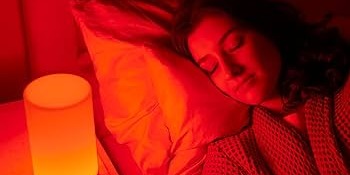The Bedroom Environment:
A dark room is best for sleep. However, in the hours before bed, warmer hues of light, such as yellows and oranges, are preferable to cooler light, like blue light from electronic devices. This is because light plays a critical role in regulating our sleep and wakefulness.
Light influences the body’s natural 24-hour biological clock that controls the timing of sleep, an important component of every person’s circadian rhythm. When it is light outside, the body knows it is time to be awake, and when it is dark, the body gets ready for sleep.
Light also affects the release of melatonin, a natural hormone that helps with sleep. The pineal gland in the brain produces melatonin in response to darkness. But, certain types of light can prevent melatonin production Trusted Source National Library of Medicine, Biotech InformationThe National Center for Biotechnology Information advances science and health by providing access to biomedical and genomic information.View Source . Exposure to bright lights and cool-toned colors, such as blue light from cell phones, computers, and televisions, can inhibit melatonin production and keep a person awake.
However, in some instances, artificial light can be used to help people with health conditions that disrupt the circadian rhythm Trusted Source. National Library of Medicine, Biotech InformationThe National Center for Biotechnology Information advances science and health by providing access to biomedical and genomic information.View Source . Light therapy works by exposing a person to bright artificial light at specific times throughout the day in order to reset the circadian clock. Light therapy may be a treatment option for insomnia, circadian rhythm sleep disorders, seasonal depression, and even jet lag.
Red Light
Red light does not affect circadian rhythms, so it is one of the best lights to use at night. Research has shown that exposure to red light can improve sleep Trusted Source. . National Library of Medicine, Biotech InformationThe National Center for Biotechnology Information advances science and health by providing access to biomedical and genomic information.View Source and increase the production of melatonin. Exposure to red light during sleep and upon waking can reduce the likelihood of feeling tired and disoriented in the morning, known as sleep inertia. However, if the red light is too bright Trusted Source. National Library of Medicine, Biotech InformationThe National Center for Biotechnology Information advances science and health by providing access to biomedical and genomic information.View Source , it can suppress melatonin production.
Yellow and Orange Light
Dim yellow and orange colored lights have little impact on the circadian rhythm and are good options to use at night. Exposure to this light may increase melatonin production, especially compared to cooler colors such as blue light.
Worst Color Light for Sleep
Bright and cool-colored light can make it harder for the body to transition to a sleepy state. In contrast to warm colors that may help with sleep, cooler colors signal to the body that it is time to wake up Trusted Source. National Library of Medicine, Biotech InformationThe National Center for Biotechnology Information advances science and health by providing access to biomedical and genomic information.View Source . Since cool light encourages attention and alertness, it may prevent sleep if viewed at night.
Blue Light
Light receptors in the eye that affect the circadian rhythm are particularly sensitive to blue light Trusted Source. More than 2 million healthcare providers around the world choose UpToDate to help make appropriate care decisions and drive better health outcomes. UpToDate delivers evidence-based clinical decision support that is clear, actionable, and rich with real-world insights.View Source . Blue light not only suppresses melatonin, it also enables the circadian rhythm to help the body maintain alertness. Regularly viewing blue light at night convinces the body that it is still daytime, which can disrupt the circadian rhythm and reduce sleep quality.
Blue light is emitted from many artificial lights and electronic screens, such as cell phones, computers, and televisions. Avoid using electronic devices that emit blue light at least one hour before bed. Additionally, consider using blue light blocking glasses, which have been shown to improve sleep among people with insomnia.
Green Light
Similar to blue light, green light also decreases drowsiness Trusted Source. National Library of Medicine, Biotech InformationThe National Center for Biotechnology Information advances science and health by providing access to biomedical and genomic information.View Source by reducing melatonin production. Although blue light can reduce melatonin levels twice as much as green light, you may still want to avoid viewing green light before bed.
Refer to the Sleep foundation org for full references













